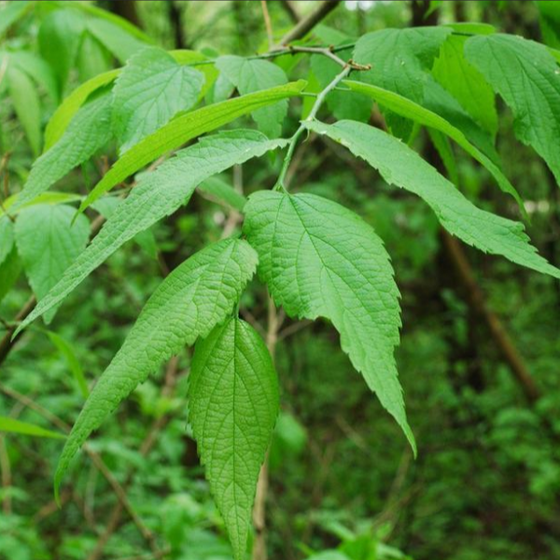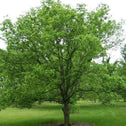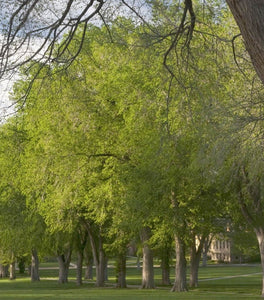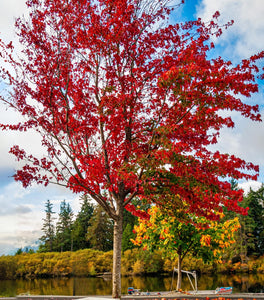Images Depict Mature Plants
Celtis occidentalis Tree (Common Hackberry) for Sale Online
The Hackberry Tree is a large tree that grows in a tall, upright, and arching habit, becoming a perfect shade tree. In optimal conditions, it can grow up to 60 feet tall at maturity.
Known as "one tough tree" the Hackberry grows in a wide range of soils. They prefer full sun. While can tolerate some shade, they may not produce as much fruit in those conditions. The Celtis occidentalis will grow where nothing else can. It is resistant to drought, heat, air pollution, and high winds.
They are native trees to central and northeastern North America; known to be one of the first berries that were harvested, stored, and eaten by humans in this area. The berry-like drupes emerge from green female flowers that bloom in the spring. These are accented by bright green serrated foliage and grey-brown bark that forms interesting, warty patterns along the trunk. In the fall, the leaves transform into a golden yellow and then this deciduous tree sheds its foliage for the winter.
| Hardiness Zone: | 3-9 |
|---|---|
| Mature Height: | 40 to 60+ Feet |
| Mature Width: | 40 to 60 Feet |
| Classification: | Broad-leaved deciduous tree, shade tree |
| Sunlight: | Full sun |
| Habit: | Upright, spreading |
| Foliage: | Bright green, brilliant buttery yellow in fall |
| Flower Color: | Inconspicuous |
| Pruning Season: | No pruning needed |
| Soil Condition | Any well-drained soil |
| Water Requirements: | Water well until established |
| Uses: | Tolerates moist soil and full sun. Full sun brings out the best fall color. Will adapt to drier sites |
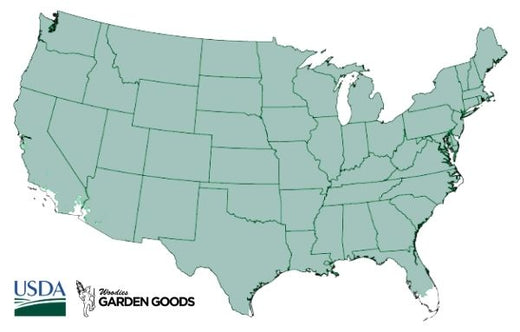
How to Care for Hackberry Tree
Before you buy a Celtis occidentalis Hackberry Tree, make sure to read about the recommended care instructions to keep this plant healthy and thriving.
How do I plant a Hackberry Celtis Occidentalis?
We suggest when planting your newly purchased Hackberry Trees that you dig a hole twice as wide as the root system but not deeper. The most common cause of plant death after transplanting is planting the new plant to deep. A good rule is that you should still be able to see the soil the plant was grown in after back-filling the hole. Depending on the quality of your existing soil you may need to add a locally sourced compost or topsoil to the back-fill soil. We do not recommend using straight topsoil or compost as a back-fill soil because more times than not these products will retain entirely to much moisture and will cause the root system to rot. Adding compost or topsoil will help the young feeder roots of Celtis occidentalis trees to spread through the loose, nutrient rich soil, much easier than if you used solely the existing soil which more times than not will be hard and compacted.
How do I water Common Hackberry Trees?
After planting your Hackberry tree, give it a slow, deep watering to allow the roots to settle. Most of the water you put on the plant at first will run away from the plant until the soil is soaked. A general rule of thumb is to count to 5 for every one gallon of pot size. For example a one gallon pot would be watered until you count to 5 a three gallon pot would be 15 and so on. Check the plant daily for the first week and then every other day there after. Fully established trees are more drought tolerant and can survive on less frequent waterings.
How do I fertilize Celtis Occidentalis Trees?
Trees, such as such as the Hackberry, grow best if they are fertilized lightly in the spring once frost has passed with a well-balanced, extended-release, fertilizer such as Espoma Tree-tone. Apply once more 6 to 8 weeks later to encourage denser foliage or faster growth of young trees. Either chemical fertilizers or organic matter can be used successfully. An organic method of applying manure and/or compost around the roots, produces excellent results and also improves the condition of the soil. Combine organic additions with a shot of chemical fertilizer for maximum effect. If chemical fertilizers are used on your Celtis occidentalis Trees, applying a slow-release, balanced fertilizer once a year is probably the simplest solution. However, fast release fertilizer such as a 10-10-10 will work just as well if applied twice during the early spring and early summer. Fertilizers formulated for trees and shrubs are ideal for this tree.
How do I mulch Hackberry Celtis Occidentalis Trees?
We highly recommend that you mulch your Hackberry Trees with either a ground hardwood mulch or a ground cypress mulch, depending on your local availability. Compared to other types, these will be of a higher quality and will provide better nutrition to your tree as they breakdown. Mulching helps deter growth of weeds as they try to compete with your new investment for water and nutrients. A 2 to 3 inch layer of mulch is sufficient, but remember not to cover any part of the stem of the plant with mulch. Its better to leave a one inch gap of space between the mulch and the trunk.


